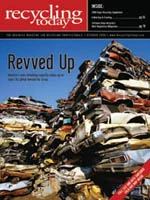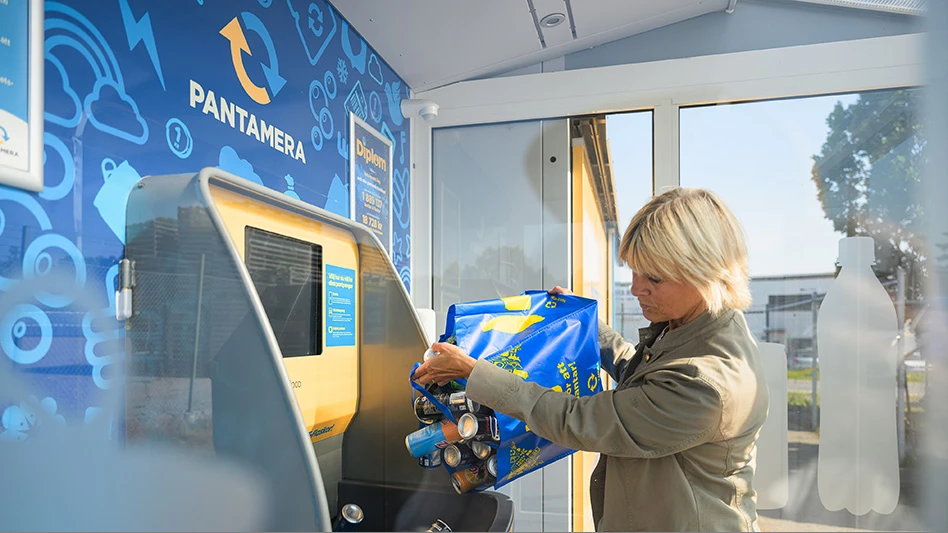 Q&A with the BMRA
Q&A with the BMRA
Lindsay Millington, director of the British Metals Recycling Association, answers what steps the association can take in boosting the recovery of material from end-of-life vehicles
Q. The European Union's target to recover 95 percent of all materials used in cars by 2015 is achievable but will depend on new technologies and services, according to the car and scrap metal industries.
What role is/can the BMRA play in reaching those numbers?
Lindsay Millington: On average, 75 percent of a car is metal, and recovering this is relatively straightforward. Metals recycling is a well-established industry, and metal can be recycled time and time again without loss of quality; so there is no doubt that all of this material will be recycled. Recovering other materials, such as plastics, glass and textiles, is more of a challenge, but metals recyclers are investing heavily in developing new solutions and markets, and progress is already advanced in these areas.
|
|
To ensure that the UK meets the EU’s 2015 target of 95 percent materials recovery from cars, the BMRA is calling for government partnership in two important areas: a ‘joined up’ system of issuing the Certificate of Destruction that records when a vehicle is scrapped, and facilities for disposal of the residual wastes that remain when all commercially viable recyclables have been recovered.
At present we have a failing Certificate of Destruction system, with loopholes which allow the illegal disposal of vehicles, outside the ATF (Authorized Treatment Facility) system. Illegal operators do not invest in the costly depollution rigs or administrative systems required of ATFs. The ATFs lose business as a result, environmental protection is ignored, and the DVLA (Drivers and Vehicle Licensing Agency) is unable to provide figures which accurately match CoDs and ELVs. The BMRA and other trade associations have been pressing for a tighter system, and this seems to be bearing fruit, the DVLA is now actively considering removing the loopholes, for instance.
Residual wastes arise because in the UK we run a completely commercial ELV system – there is no subsidy from government or levy on new cars, as is the case in some other European countries. Thus there comes a point when it is no longer financially viable to separate out residuals, particularly if there is no market for what would then be recovered. At present this goes to landfill, but longer term we need energy from waste or similar facilities that would enable the residuals to be turned into energy, and thus count towards European targets for recovery. Such facilities are available in Europe, but at present in the UK are only being developed in any significant capacity for municipal wastes. The BMRA raised this with the Environment Minister, Joan Ruddock earlier this summer, and is hopeful that as a result some government-industry talks may start soon.
The UK has made a strong start in recycling end of life vehicles. It is certainly up amongst the pace-setters in Europe, recovering more cars than any other European country. Every year some 2 million vehicles reach the end of their life in the UK. They don’t end up in landfill and they’re not fly-tipped. Every year 1.5 million metric tons of metal and around 100,000 metric tons of other materials are recovered from vehicles as secondary raw materials. It is the UK’s biggest recycling success story.
Several factors contribute to this: first, there is a good collection system, which works through pre-existing metal recycling facilities and vehicle dismantlers. Thus there is a strong network of ‘ATF’ facilities, authorized to receive end of life vehicles and depollute them – removing tires, batteries and hazardous liquids such as fuel. Secondly, our right-hand-drive vehicles don’t get exported to Eastern Europe, so once they are scrapped they do all get recycled. And thirdly, our larger metals recycling companies are world leaders in developing and installing advanced shredder and media separation technology – and the markets for the new materials recovered.
Sponsored Content
Labor that Works
With 25 years of experience, Leadpoint delivers cost-effective workforce solutions tailored to your needs. We handle the recruiting, hiring, training, and onboarding to deliver stable, productive, and safety-focused teams. Our commitment to safety and quality ensures peace of mind with a reliable workforce that helps you achieve your goals.
The UK recorded slightly under the 85 percent target the EU set for 2006 and performance is improving year on year. With a little more government partnership, we will be able to achieve the 95 percent reuse, recycling and recovery, by 2015.
Get curated news on YOUR industry.
Enter your email to receive our newsletters.

Explore the October 2008 Issue
Check out more from this issue and find your next story to read.
Latest from Recycling Today
- Nucor expects slimmer profits in early 2025
- CP Group announces new senior vice president
- APR publishes Design Guide in French
- AmSty recorded first sales of PolyRenew Styrene in 2024
- PRE says EU’s plastic recycling industry at a breaking point
- Call2Recycle Canada, Staples Professional expand partnership
- Circular Services breaks ground on north Texas MRF
- Tariff uncertainty results in choppy nonferrous scrap flows








